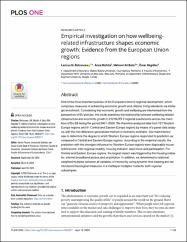Empirical investigation on how wellbeing-related infrastructure shapes economic growth: Evidence from the European Union regions
Citation
Batrancea LM, Nichita A, Balcı MA, Akgüller Ö. Empirical investigation on how wellbeing-related infrastructure shapes economic growth: Evidence from the European Union regions. PLoS One. 2023 Apr 19;18(4):e0283277. doi: 10.1371/journal.pone.0283277. PMID: 37074990; PMCID: PMC10115347.Abstract
One of the most important policies of the European Union is regional development, which comprises measures of enhancing economic growth and citizens' living standards via strategic investment. Considering that economic growth and wellbeing are intertwined from the perspective of EU policies, this study examines the relationship between wellbeing-related infrastructure and economic growth in 212 NUTS 2 regional subdivisions across the members of Eu-28 during the period 2001-2020. We therefore analyzed data from 151 Western Europe regions and 61 Central and Eastern Europe regions by means of a panel data analysis with the first-difference generalized method of moments estimator. Our main interest was to determine the degree to which Western Europe regions responded to predictors as compared to Central and Eastern Europe regions. According to the empirical results, the predictors with the strongest influence for Western Europe regions were disposable household income, inter-regional mobility, housing indicator, labor force and participation. For Central and Eastern Europe regions, the largest impact was triggered by the housing indicator, internet broadband access and air pollution. In addition, we determined a relational weighted multiplex between all variables of interest by using dynamic time warping and we introduced topological measures in a multilayer multiplex model for both regional subsamples.


















